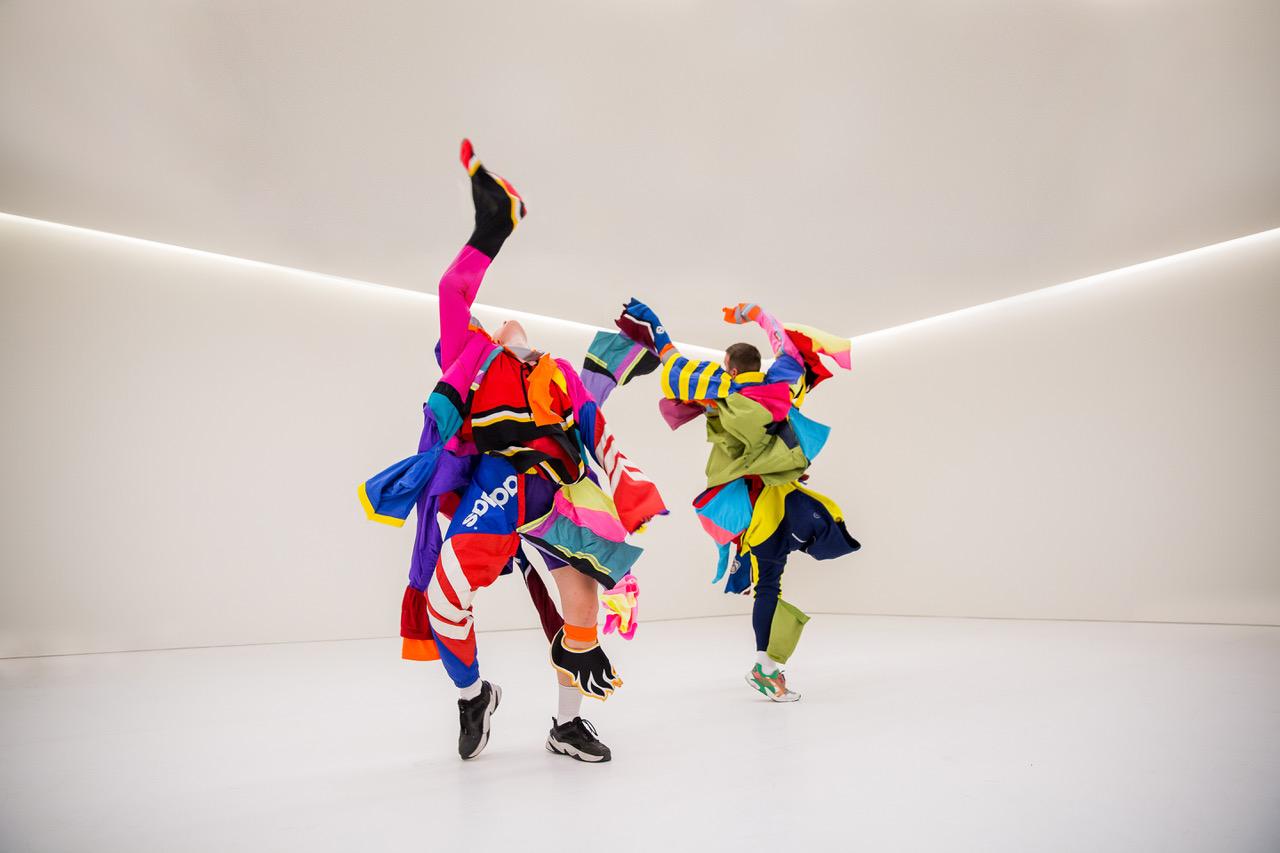Words by Adam Moore.
We go to the back of a not so long, snaking line – from the glass doors to the tapestries, back through the room and into the adjacent gallery. The queue cuts across the room. Perhaps 45, 50, people deep. Friends tell me we need a sticker, and the last person to get one was the woman in the stripy top in front. ‘I’m meant to review this’, I say. I look at the front of the queue and see some friends of the museum. I wait while they chat.
Theo Clinkard’s cuter-than-cute father, who is like a lean, cleaner silhouette of Santa, with a beaming pink face explains how the programme has no mention of tickets or queues – ‘it’s terrible’, he says (or something like that). Well, Theo and Leah are very popular, I say, looking at the queue. He smiles; what a beaut’. Dance dads are everything. The 30 people go in, 32 with me and my friend (no stickers).
The tinny sound from the laptop lighting their naked bodies beneath a fog of lilac is distorted.
People did cry
The sun went down
The sun came up
Orange and grey
Orange and Grey
I have been sat here so long with the tapestry, watching, and listening intently, that my brain adjusts the clarity. I wish I could hear and remember more. Romantic and poetic, and slow and soft and forlorn. Longing, lingering on the past, an elegy of sorts, two bygone human beings in not quite suspended animation, connect with themselves through gentle touch. This is dance. Leah looks like Venus. Theo looks like Venus. They are human and humane. It goes on and on. I am comfortable watching and listening for longer than we are given. They are generous performers, and they give a lot. It is not a test of endurance. The more you observe the more you receive.
The performance of the Elsewhen Series is supposed to have a kind of quiet guerrilla tactic about it, spontaneous, unannounced. The museum is a beautiful setting and there are resonances with the series and the spaces these performances enliven which could be extrapolated from at depth. Unfortunately, some of the museum’s solutions to how these dances were experienced, rendered the Elsewhen Series a little flatter than intended. The ticketed performance in the tapestries excluded all but 32 visitors, contradicting the ‘Elsewhen’ of it all – the idea being that these dances might be stumbled upon in various places at various times.
Clinkard and Marojevic create different planes of reality: a realm of Trisha Brown-esque, skirt-swoosh articulacy; another, an unruly dimension conjuring womble-human hybrid beings, dropping into the splits, outside.
I see two-out-of-five dances. Utterly disappointed, I enjoy the idea that various pockets of reality are slipping by, and that I might find my way into another (where I arrive on time and see more dances). A version of the dynamic duo with gas masks and goggles might still be scuttling elsewhen in the museum, while I watch Leah and Theo now, at the ground floor staircase leading to the library, as they sensually slow-mo their way through air like treacle: urban ninjas on a bloody, wipe-down flying carpet that ends up crumpled – the way I feel sat amongst the masses. It is sensate: they sing, they move, (again) they look smashing. The varied aesthetic of the five dances in the series is well thought out — no head-to-toe-black or earth tones. In this last dance of the series, they de-mystify. Leah and Theo, dancing before us, here and now, sing, between breaks in a thumping, pulsing instrumental – they ‘feeel aaand feeel – to move’. I take this work personally and prophetically: to move away from the misguided socio-political preoccupations that beset us, and towards a more geologically healing impact, we need to slow right down, to feel. I slow right down, I feel, and I wonder.
Five dances, five aesthetics, one grand museum. All credit to Clinkard and Marojevic — their presence rivalled that of the V&A, its institutional history, and artefacts. Programmed by Jenna Mason, locating these dances within the V&A Friday Late: Anthropocene programme felt timely. Not only do we see the performers soften, but perhaps we soften enough to question how we observe – as expectant consumers – and what we receive from witnessing. Loosely reflecting on the human as geological force through dance feels possible, and helpful, and important.
In such a huge museum setting, the durational nature of these performances works remarkably well, however, more thought might be required to find ways where the resolution of durational work like this leaves audiences clearer on when a performance has found its ending. Located in galleries and museums, dance does something rather remarkable that objects cannot do; no matter how long someone might stare into a painting, people just cannot leave dance until the very last breath is expelled. Crowds gathered uncomfortably close for the last dance. Cute, polite, institutionalised audiences, not knowing whether they had permission to leave, or if they were making a faux pas by doing so, was amusing. These dances were supposed to sprawl away, it was permissible to leave after a point, but, like a Marvel movie with post credit scenes, nobody wanted to miss a moment.
After seeing this beautiful and engaging series in such a grand and versatile setting, I do not quite know how the Elsewhen Series will materialise next, but I would recommend stumbling upon if you can. And if you arrive late (like I did), and miss one or two, the series allows you to conceptually reframe your tardiness – part of the experience – never quite knowing when one dance finishes and another has begun. You arrive. Elsewhen.
Header image: Roswitha Chesher.
